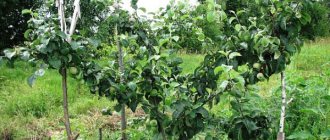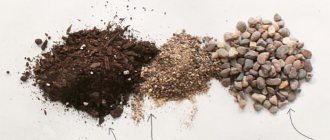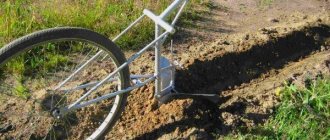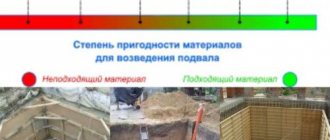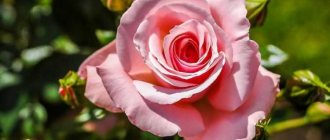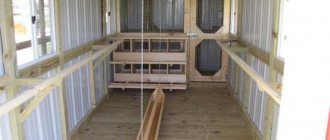The colorful perennial heuchera is an excellent solution for the garden if you want to create a spectacular border, design a garden path, rock garden, or simply plant a lawn. The advantage of the plant is that it does not require special care. However, like many perennial flowers, these bushes require shelter during cold weather so that the root system does not die. So, we will tell you how to prepare heuchera for winter.
Heuchera - preparation for winter
Heuchera naturally remains in the soil for the winter. In the southern regions, where the cold season is mild and without severe frosts, no preparatory measures are needed.
It’s another matter if your garden is located in the middle zone, where winter frosts are a fact of life. Despite the fact that heuchera is considered a frost-resistant plant, we still recommend protecting it.
First, let's figure out whether the heuchera needs to be pruned for the winter. Some gardeners believe that since the leaves and flower stalks of the plant die anyway, they should be removed for aesthetic reasons. In fact, this is a misconception. The fact is that the growth of heuchera rhizomes does not occur deep in the soil, but closer to the surface of the earth. Because of this, the growth buds are practically bare. Severe frosts can be destructive for ornamental bushes. If the heuchera foliage is left, it will become a natural shelter. You can only remove flower stalks, which cannot protect the underground part of the plant in any way.
Heuchera - shelter for the winter
If in your homeland there is a winter with frosts below ten degrees, the plant’s own leaves will not be enough. The owner will have to take care of the protection himself.
The ideal shelter for heuchera is sphagnum moss, which is simply placed on top of the leaves above the rhizome. Where such shelter is impossible to obtain, preparing heuchera for winter includes hilling the roots with humus or soil. Also, the base of the bush rosette can be covered with a layer of sawdust or even oak leaves. Adult plants do not need additional protection; we recommend covering young bushes with insulating material, for example, agrofibre.
In the spring, the cover is removed, and last year's leaves, which protected the heuchera in winter, are carefully cut with pruning shears as low as possible to the soil surface.
As you can see, preparing heuchera for the winter cold is not a difficult matter. But the plant will tolerate this time of year well and will delight you with beautiful foliage and bright blooms.
Heuchera decorates the garden from early spring to late autumn. And even for the winter it leaves with decorative leaves. How to grow such a beauty in a flower garden?
Heuchera is widely used in landscape design. Most often it is planted in rock gardens, rock gardens, ridges and central flower beds near the entrance to the house. This plant is unpretentious, but if improperly planted and poorly cared for, it does not look very presentable.
Choosing a landing site for heuchera
The richness of the color of heuchera leaves and the duration of flowering of the plant largely depend on the place of growth. Most species prefer semi-shaded areas where the sun shines only in the morning or evening - the eastern or western side is suitable. However, young bushes develop better with more sunlight. It is important that they are protected from the wind.
Heucheras with brightly colored leaves, especially red ones, look richer in the sun. But in such conditions, plants need abundant and frequent watering.
Red-leaved Heuchera Peach Crisp loses its bright color in the shade
Heykhra is unpretentious in the choice of soil, but grows best on light, fertile and well-drained slightly acidic soil with a pH level of 5-6. The plant does not tolerate stagnation of water: with excessive moisture, its roots rot.
Planting heuchera
The most suitable time for planting is early spring. Heuchera can be grown from seeds, but this is an unreliable method of propagation, since the young plant often does not receive the varietal characteristics of the mother plant and, as a result, grows with unremarkable green leaves. Therefore, heuchera is most often grown from a seedling - a bush purchased in a specialized store, or a cutting of a bush.
In the selected area, dig a hole 30 cm wide and deep, add ash and rotted compost to it and mix well with loose fertile soil.
On a heuchera bush, dry shoots are removed, long stems are shortened to young tissue, damaged and rotten areas are cut out and sprinkled with crushed charcoal. After which the heuchera is planted in the prepared hole, watered and shaded.
When planting, maintain a distance of about 25 cm between plants.
After 4-6 weeks, the root system of young plants becomes strong and well developed - then they can be transplanted to a new location. In regions with an unstable climate, in March-April, heuchera is first planted in a greenhouse, and after stable warm weather has established, it is transplanted into open ground. Or young bushes are planted no earlier than May.
When planting in spring, after watering, it is recommended to mulch the heuchera with peat. This will help get rid of weeds and retain moisture in the soil.
In the same way, divisions with 2-3 rosettes can be planted in September, but it should be taken into account that they take root in 1-1.5 months, and during this time it is important to protect the plants from a sudden drop in air temperature.
Further care after winter
With the first rays of the spring sun, the bushes awaken. It is necessary to clear the bushes of last year's leaves, remove shelters for the winter, water with warm water and feed the awakened bushes. You should not overuse fertilizers; heuchera is used to growing on poor rocky soils. The concentration of mineral complexes can be underestimated by two times.
Every spring, plants are sprayed against pests and fungal diseases, and sprinkled with wood ash. The bushes can be mulched with humus and a mixture of peat and sand after hilling the plantings.
Powdery mildew is the main disease of Heuchera. In April, preventive treatment of bushes is carried out with Bordeaux mixture. To improve the brightness of the leaves, plants are sprayed with a solution of brilliant green in the ratio: 10 drops of the product per 10 liters of water. Heuchera is propagated by seeds, cuttings or by dividing an adult bush. Young seedlings are planted in the ground in the spring, when the soil and air temperatures are above +12 C and the threat of frost has passed. The plant is planted with seeds for seedlings in early March. It is not recommended to plant young bushes in the fall, before winter.
Heuchera care
The plant needs regular watering as the soil dries out - usually once every 2 days. But during droughts, more frequent watering may be necessary. In this case, you need to ensure that moisture does not stagnate in the soil and that drops do not fall on the leaves. Otherwise, the bright sun may cause a burn.
If the leaves of the heuchera become dull, small or sluggish, and the flowers do not bloom for a long time, then before and after flowering the plants are fed with complex mineral fertilizer. In this case, the dose recommended in the instructions for the drug is reduced by 2 times. After all, it is better to underfeed a heuchera than to overfeed it.
Heuchera usually blooms throughout the summer. Immediately after this process is completed, faded flower stalks are cut off so that the plant does not reproduce by self-sowing.
Heuchera grows well in one place for no more than 5 years, then its bush begins to fall apart and may freeze in winter, so every 3-4 years the plant is dug up, divided and replanted.
Heuchera tolerates transplantation well and quickly takes root in a new place.
In autumn, with the onset of cold weather, some heucheras turn yellow, but often snow covers bushes with still bright foliage. The shoots are not cut off: they overwinter well in this form and at the same time protect the root system from frost. In regions with cold climates, heuchera is additionally covered with dry leaves (preferably oak) or spruce branches.
In the spring, the cover is removed and last year's heuchera leaves are trimmed using pruning shears as close to the soil surface as possible.
Possible difficulties
A correctly selected variety and systematic care reduce the risk of growing failures to zero. Nuances of plant care:
- Planted on the western or eastern side of the garden plot. To improve the brightness of the leaves, good lighting of the bush is necessary.
- Do not allow moisture to stagnate at the roots. It is better to skip watering than to overwater the plant.
- Do not make unnecessary plant transplants, the heuchera will take a long time to get sick and grow; only adult bushes with a formed root system are replanted.
- Some varieties need shade.
- In the middle zone, plants should overwinter under shelters.
- Soils are chosen with an alkaline reaction.
- The best neighbors are shade-tolerant plants.
Heuchera diseases and pests
As a rule, heucheras rarely get sick and practically do not suffer from pests. But with improper care, they can become infected with powdery mildew (which can be eliminated by spraying with fungicides - Topaz, Fundazol, Bayleton), rust and leaf spots (a 1% solution of Bordeaux mixture is effective against these ailments).
If there is excessive moisture, heuchera can be eaten by snails and slugs . To avoid this, carefully monitor watering, periodically collect pests by hand and, if necessary, place traps in the flower garden.
Plant spectacular heucheras on your site - and they will brighten even the most boring flower garden with bright colors. And if you want these flowers to decorate your home, grow them in containers. Heucheras grow well at home.
Heuchera is a perennial plant of the Saxifraga family, native to the highlands of North America. Its natural habitat is poor mountain soils, so heuchera does not require special maintenance conditions.
The flower will decorate any garden thanks to the wide variety of varieties of leaves that differ in color. It is they who give this plant its decorative effect. Heuchera grows as a low, lush bush no more than 30 cm high; flower stalks can grow up to 90 cm. Flowers of red, white, and pink bloom on them. Landscape designers love heuchera and use it to decorate borders, alpine slides, and artificial ponds.
Types and varieties
The genus Heuchera has approximately 70 species. Many of them grow naturally in forests and woodlands of the mountainous regions of Mexico and the United States. Heuchera species are conventionally divided into mountain and forest. We will introduce you to the most popular species and varieties among gardeners, which are used in landscape design and for breeding new varieties.
Blood red heuchera (Heuchera sanguinea)
Belongs to mountain species. It has green leaves and bright red flowers. Americans call it the red bell. The leaves of Heuchera blood-red, forming a rosette, are much denser than those of other species, they are round and jagged. Some varieties of this species are distinguished by beautiful white or cream specks on the leaves. Peduncles reach a height of 50 cm. This species is cold-resistant, which is why it is so popular among our gardeners. The most famous varieties are Monet, Variegata, Hercules.
In the photo: Blood-red Heuchera (Heuchera sanguinea)
Heuchera villosa
It is distinguished by large leaves with a velvety surface and pubescent peduncles and cuttings, which is why it got its name. The Bronze Wave variety has the largest leaves, up to 20 cm in diameter, bronze color, and Rachel has not only flowers, but also peduncles of a soft pink color.
In the photo: Hairy Heuchera (Heuchera villosa)
Heuchera cylindrica
Also a mountain species, it not only has spectacular leaves, but also tall peduncles with a cloud of small flowers that seem to hover above the bush during flowering. This species is larger than others, and this attracted breeders who developed new varieties based on Heuchera cylindrical. Peduncles reach 90 cm in height; large flowers of white, pink, green and coral colors bloom on short stalks. The leaves are heart-shaped, round, green with a silver pattern or veins of contrasting color. Varieties: Greenfinch with greenish-cream flowers, Hyperion - a compact bush with a peduncle height of only 50cm and red-pink flowers.
In the photo: Heuchera cylindrica
Heuchera micrantha
According to many gardeners, this is the most spectacular of the heucheras. Its leaf, shaped like a maple, is covered with silver spots, and some naturally occurring specimens have purple leaves. The paniculate inflorescence on a peduncle 60 cm in height consists of small creamy-pink flowers with orange anthers. Among the popular varieties, the best known are Palace Purple with dark purple leaves, which is the best perennial plant of 1999, and Bressingham Bronze with bronze-brown leaves.
In the photo: Small-flowered Heuchera (Heuchera micrantha)
American Heuchera (Heuchera americana)
Growing on the shores of the Great Lakes. In the USA it is called mountain geranium. It attracts with its leaves, forming a rosette about 20 cm high. On the underside, the leaves are brown-lilac in color, heart-shaped, round, with long petioles. The panicles on peduncles 50-60 cm high consist of yellow-green flowers. Green Spice is one of the most beautiful varieties of American Heuchera with green leaves and contrasting silver spots on them. During the growing season, the leaves change shades of green from yellower to darker, the silver spots increase, and a purple hue appears around the veins.
- Mahonia: growing at home and in the garden
In the photo: American Heuchera (Heuchera americana)
Heuchera hybrida
This includes interspecific hybrids of American heuchera and blood-red heuchera with the participation of small-flowered heuchera. The flowers of this species resemble the flowers of the blood-red heuchera, but they are somewhat larger, as are the leaves with peduncles. White, coral, red or pink flowers bloom for more than two months. The leaf color is mostly green, but with contrasting veins and cream markings. The only drawback of these hybrids is that the flower stalks may fall due to strong wind and rain. Varieties: Cancan, Cappuccino, Beauty Color, Ruby Vale and others.
In the photo: Hybrid Heuchera (Heuchera hybrida)
Heuchera grossulariifolia
This plant is so cold-resistant that even after wintering in the garden in severe frost it can completely retain its leaves, and it is this rare quality that attracts both flower growers and breeders.
Features of growing heuchera in the garden
It is not difficult to grow heuchera; it does not make any special demands on its maintenance. But some rules will have to be followed in order to preserve the beauty of its leaves, which serve as its main decoration. These rules apply to the soil, lighting and watering of the plant. Heuchera winters well in the garden if it is provided with reliable shelter from frost. It will grow well in almost any soil, as long as it is well-drained.
An important feature of heuchera is its ability to get along with almost all garden plants, so you can choose almost any place, based on how you want to decorate this or that corner of the garden.
There are varieties of heuchera that bloom with inconspicuous small flowers that do not decorate the plant at all. Unless there is a need to collect seeds, it is better to remove flower stalks so that they do not spoil the appearance of the flowerbed.
Planting heuchera in the ground in autumn (spring)
Heuchera is planted in the ground as seedlings; it is advisable to use seedlings with a closed root system (in pots). At first, it is provided with abundant watering and shading. When the seedlings become stronger, they can be moved to a permanent place.
Planting methods
There are two methods of planting - seeds and seedlings grown from cuttings or taken from a divided old bush. Moreover, planting heuchera with seeds absolutely does not guarantee the preservation of species qualities, especially decorative ones. Therefore, experienced gardeners prefer to plant heuchera seedlings.
Optimal time for planting
Heuchera is usually planted in the ground in the spring, when the last frost has already passed. However, you can do this in the fall, if it is warm and long.
Important! When planting heuchera in the fall, be sure to mulch the soil with wood ash or bark; in the spring, be sure to remove the mulch.
Soil for the plant
Any soil of neutral acidity or even slightly alkaline is suitable for heuchera. The main thing is its water and breathability. To do this, drainage is poured into the hole to a certain depth before planting. Since in nature heuchera grows on rather poor soils, fertile garden soil will give good growth and lushness to its bush.
Features of heuchera care
The main features of care are the feeding regime, the choice of location and lighting, and the need to hill up the plant. Hilling is necessary due to the fact that as the heuchera roots grow, they begin to protrude above the ground and must be covered.
Important! Heuchera needs to be earthed up in the fall, as part of measures to prepare the plant for wintering.
Location and lighting for the plant
For different varieties of heuchera you need to choose a different place. Most often, a plant needs good lighting, but not bright direct rays of the sun, but an openwork shadow. The best place in the garden will be where the sun is only in the morning or evening. Some varieties from too hot sunlight can not only lose the color of the leaves, but also change their shape, which is also one of the components of the decorative qualities of heuchera.
On the contrary, varieties with red and burgundy leaves are best planted in a place where there is more light, because in the shade their leaves may remain green.
Do not plant heuchera in places where melt or rain water can stagnate, the plant may simply rot.
Air humidity
The air humidity in the garden is optimal for plant growth. There is no need to take additional measures to increase it.
How to water correctly
There is no need to water the heuchera too often. It is enough to do this once every two days as the soil dries out and only in dry summers. If the weather is very hot, then watering should be done twice a day - in the morning and in the evening, when the heat subsides.
Important! When watering, avoid getting water on the leaves. They may cause burns.
Feeding and fertilizing the plant
In the first year of life, the young plant does not need feeding at all. You can start fertilizing heuchera in the second year and little by little. This feature of the flower is due precisely to its origin and natural habitat on mountainous rocky poor soils.
Experts say that it is better to underfeed heuchera than to overfeed it. Some recommend fertilizing once a season, others twice, before and after flowering.
For feeding, it is better to use mineral fertilizers, and their concentration should be half that for other plants.
Varieties and varieties of heuchera with photos
The Heuchera genus has many varieties that can only be found in natural habitats. Only a few of them are common in gardening and design.
This plant belongs to the mountain varieties of heuchera. The leaves are green, the flowers are bright red. The buds of this variety form a dense rosette. Particularly valuable are varieties with white and cream spots on the leaf plate. During the flowering period, the plant produces a panicle, the length of which is up to 50 cm. The winter hardiness of the variety is good.
One of the most ornamental plants. The leaves are shaped like maple leaves, and bright silver streaks give them a special decorative effect. The peduncles are tall, up to 60 cm. The flowers are cream-colored.
These plants include all interspecific hybrids that are obtained by crossing. Their leaves and flowers are much larger than those of the parent plants. The color of the flowers ranges from white to red. The leaves are green in color with various speckles. The disadvantage of hybrid heucheras is their low frost resistance and fragility of peduncles, which are easily damaged by gusts of wind.
Heuchera pruning
The plant needs pruning, but not the leaves, but the flower stalks.
Trimming methods
In some heuchera varieties, flowering can spoil the beautiful appearance of the flower bed. Due to the long peduncles and inconspicuous flowers, it takes on an unkempt appearance. Therefore, it is better to cut them off as soon as they appear. If you let the heuchera bloom, then you must remove the flowers along with the long stems.
Heuchera leaves are pruned only in the spring and only those that have dried and died.
Important! In spring, you can cut off old leaves only after new shoots begin to grow.
Pruning for winter
Under no circumstances should heuchera be trimmed in the fall before preparing it for wintering. Old leaves will serve the plant well - they will protect its root system from freezing.
Heuchera transplantation in spring (autumn)
An annual transplant of heuchera is not necessary; it is carried out only for the purpose of rejuvenating the plant. After 4-5 years, the flower loses its decorative qualities, and the bush itself falls apart. That's when he will need a transplant. Transplantation can be done both in early spring and autumn.
Transplant methods
The bush is divided into several parts and planted separately from each other. Before planting, you need to carefully examine the roots and remove any rotten or diseased ones. Sprinkle the sections with ash.
The distance between seedlings should be at least 20-25 cm. Planting is carried out in a hole up to 30 centimeters deep with good drainage and loose soil.
Heuchera propagation
Heuchera is propagated in several ways. Since heuchera does not live very long, its propagation is a way of rejuvenation and preservation of a very beautiful ornamental bush in the garden.
Reproduction methods
Heuchera propagation by cuttings
For cuttings, lateral shoots are taken from heuchera. This should be done after flowering has ended. The cuttings are cut together with a fragment of the rosette. If the shoot is long, it can be cut into short (3-4 cm) parts and the lower sections treated with a root formation stimulator. It is not necessary to dig up the plant for this, unless it is replanted at the same time. When dividing a bush, you can also separate cuttings for propagation. Sections must be treated with ash.
The cuttings are planted in prepared holes in loose peat soil and covered with film, creating greenhouse conditions. The greenhouse should not be too hot. Rooting occurs within about a month.
Important! If the cuttings have taken root closer to autumn, then it is not recommended to plant them in open ground; it is better to leave them over the winter in the cuttings, covering them well with leaves, moss or spruce branches.
Heuchera propagation by seeds
When purchasing seeds for planting, you must take into account that they can sprout only within six months after ripening. It is best to plant seeds in early spring.
Before planting, they must be mixed with wet sand. The soil should be loose. The seeds are not buried, but placed on top of the ground and covered with film. Seedlings need good lighting and constant soil moisture, but without overwatering. The first shoots appear after two weeks.
After the first leaves appear, the seedlings are planted in separate pots. These pots can be dug into the ground in the spring in the place where a permanent place for the heuchera is planned. By autumn they will have their first leaf rosette.
Leaf propagation
Propagation of heuchera by leaves is possible, but it is practically not described in the literature by specialists, and most likely is not practiced.
Reproduction by dividing the bush
This is the most common method of propagation of heuchera. After three to four years of life, the plant must be replanted. To do this, the bush of the old mother specimen is divided into several parts, planted and several new young plants are obtained.
The heuchera is dug out of the bed, the roots are carefully inspected and cleaned of rot. The rhizome is divided into several parts so that each of them has 2-3 rosettes, the stem is cut to new tissue. Cuts on the roots are treated with root.
When preparing the planting site, the hole can be filled with compost and coarse sand or pebbles can be added as drainage. The place where young new bushes will be grown should be well lit, but the light should be diffused. You can cover the seedlings with a wooden box made of slats to provide light shade and good ventilation.
Rooting occurs after one and a half to two months. Then the seedlings can be moved to their permanent place.
Problems, diseases and pests of a flower
Heuchera, living in nature in rather harsh conditions, is quite resistant to pests and diseases. During too rainy summers it can be affected by powdery mildew, which is easily removed with the help of fungicides.
The leaves and rhizomes of the plant can be harmed by weevils (they eat thin roots) and slugs that gnaw holes in the leaves. To avoid such problems, you need to sprinkle the ground around the heuchera with sawdust soaked in creolin, or sprinkle the soil with lime, which will repel slugs. Mustard water, which should be sprayed on the bush (1 tablespoon of mustard powder per 1 liter of water), will also be effective against weevils.
Shelter for the winter
The root system does not go deep into the ground, it is located close to the surface, therefore, in order to avoid freezing, the plant is covered for the winter with various additional shelters:
fallen leaves;
Description of the 20 best varieties of perennial scabiosa, growing from seedsRead
The basic rule is that the bush must “breathe”. Do not cover the roots with film covers, this can cause rotting or fungal infection.
Covering the bushes with sphagnum will preserve the root system and create additional antibacterial protection; in addition, the remains of dead moss serve as an excellent organic fertilizer. Before preparing for the winter, the bushes are hilled.
Popular types (varieties)
Heuchera blood red
It was from her that the main garden varieties of heuchera came. Its bright red flowers serve as an additional decoration for the plant. It has denser pubescent leaves than other varieties and beautiful bright red or pink small flowers, shaped like a bell.
Heuchera americana
A small bush about 20 cm tall is distinguished by its heart-shaped leaves and beautiful veins on them. The most popular garden variety is “Green Spice” with silver veins on a green background. Flowers are not decorative; they need to be removed when flower stalks appear (unless you want to get its seeds).
Heuchera tremulosa
A specially bred hybrid with a wide variety of leaf colors.
Heuchera parviflora
One of the most beautiful types of heuchera, which has several garden varieties. It is distinguished by the shape of a summer leaf, reminiscent of a maple leaf. The variety “Purple Palace” with its bright purple leaf color is the most popular among gardeners.
Botanical description
The dense bush of heuchera is formed by leathery, serrated leaves on long cuttings. The shape and color of the leaves is amazingly diverse: almost black, bright red, dark burgundy, amber, pink, purple, yellow, green and even silver leaves in all kinds of patterns and veins, specks and spots. The texture of the leaves is smooth, corrugated and curly. Heuchera blooms all summer, and even until frost, with small pink, white, cream or red bells collected in panicles. The heuchera fruit is a capsule in which seeds the size of a poppy seed ripen (about 20,000 seeds fit in 1 gram).
Heuchera has been used in landscape design for a long time. Designers divide heuchera varieties into two categories: decorative-deciduous, the ancestor of which was American heuchera, and decorative-flowering, such as red or blood-red heuchera.
- How to care for garden roses
Difficulties in growing the plant. Useful tips
There are no difficulties in growing heuchera, but here are some tips that will help you grow healthy, beautiful flowers that will decorate your garden for a long time.
- Plant heucheras in places where moisture will not stagnate. It is better if these are small mounds. This is especially true for blood-red heuchera; it is most vulnerable in conditions of high soil moisture.
- If you mulch the soil around the heuchera with peat in the spring, during the summer you will not have to constantly fight weeds and frequently loosen the soil.
- When growing heuchera in a greenhouse, light hygroscopic material can be laid along the arc. It will absorb excess moisture.
- After sowing, the seedlings need to be watered very carefully - only along the walls of the container.
- Before sowing seeds, it is better to calcine the soil or pour boiling water on it. Seeds can only be sown in dry soil.
Answers to readers' questions
Plant lifespan
After three to five years, the plant loses its qualities, the bush disintegrates and the heuchera needs to be dug up. The old bush is divided into several parts and planted. Young plants are obtained from them. So heuchera has a long, renewable life cycle.
Why does heuchera grow poorly?
The reason may be too fertile soil or excess fertilizer due to which by autumn a large bush grows and too many buds are laid. Over the winter, the root system weakens and cannot “feed” so many new shoots.
Perhaps some conditions do not meet the requirements (humidity, windy place in the garden, too dark or, conversely, too bright place in the garden).
Flower care in winter
In winter, the flower does not require care, but in the fall you need to take care of it. Pruning is strictly prohibited; the bush is carefully covered with foliage or spruce branches. It is imperative to mulch the soil with compost or rotted tree bark. You can add wood ash. In the spring, the mulch is removed.
It’s hard to believe, but there are decorative foliage plants whose bright greenery can outshine the most spectacular flowers. A sign of this is heuchera, planting and caring for it in open ground is completely simple and accessible to summer residents in many regions of Russia.
In what cases is it necessary to cover a plant for the winter?
Heuchera is a relatively frost-resistant plant. In the southern regions, there is no need to carry out any preparatory measures for the cold season. In central Russia, the bush should be closed. In winters with little snow, the root system may suffer and freeze.
Important! If in winter the air temperature drops below minus 10 degrees, then it is recommended to cover the heuchera bushes.
With the onset of spring warmth, additional shelters are removed, the heuchera is cleaned of last year's dried leaves and mineral supplements are applied. Young bushes are hilled and mulched with peat or humus. It is not recommended to use fresh manure; the plant may become sick and burn.
Description of heuchera for open ground
All types of heuchera existing in nature come from the American continent. Here, plants from the Saxifraga family, justifying their origin, settled across the rocky wastelands of the central and southern United States and some parts of Mexico. Most of the plants domesticated by humans are perennial decorative deciduous crops. According to the description, in the open ground, heuchera, which forms a lush rosette of split palmate leaves, changes their color depending on the season, miraculously transforming the corner of the garden allotted to it.
The appearance of foliage depends not only on the season, but also on the variety of heuchera. Thanks to two- or three-color leaves with jagged, smooth or corrugated edges, you can transform the most inconspicuous area.
The decorative effect is complemented by flowering that lasts all summer. The brightest inflorescences on erect peduncles are blood-red heuchera with small coral-colored corollas. In other species, the flowers are predominantly white or pinkish, collected in sparse paniculate inflorescences.
When to plant heuchera in open ground? What do you need to know about the nature of the plant and its preferences?
When to remove insulation
Heuchera can suffer not only from frost and wind, but also from scorching sun rays. Therefore, at the beginning of spring, when the frosts have subsided, the shelter needs to be removed, but not completely. If possible, you should leave a canopy of covering material so that the ground has time to warm up and the root system begins to function normally.
After the bush has adapted to the spring warmth, last year’s leaves, which served as protection for the roots, must be completely cut off. There is no need to be afraid: thanks to proper spring care, the bush will soon become even larger and more beautiful.
When preparing for winter and covering heuchera, be sure to take into account the characteristics of the variety and the characteristics of winter in the region. Improper care can destroy a plant faster than frost or sun.
The colorful perennial heuchera is an excellent solution for the garden if you want to create a spectacular border, design a garden path, rock garden, or simply plant a lawn. The advantage of the plant is that it does not require special care. However, like many perennial flowers, these bushes require shelter during cold weather so that the root system does not die. So, we will tell you how to prepare heuchera for winter.
Heuchera - preparation for winter
Heuchera naturally remains in the soil for the winter. In the southern regions, where the cold season is mild and without severe frosts, no preparatory measures are needed.
It’s another matter if your garden is located in the middle zone, where winter frosts are a fact of life. Despite the fact that heuchera is considered a frost-resistant plant, we still recommend protecting it.
First, let's figure out whether the heuchera needs to be pruned for the winter. Some gardeners believe that since the leaves and flower stalks of the plant die anyway, they should be removed for aesthetic reasons. In fact, this is a misconception. The fact is that the growth of heuchera rhizomes does not occur deep in the soil, but closer to the surface of the earth. Because of this, the growth buds are practically bare. Severe frosts can be destructive for ornamental bushes. If the heuchera foliage is left, it will become a natural shelter. You can only remove flower stalks, which cannot protect the underground part of the plant in any way.
Heuchera - shelter for the winter
If in your homeland there is a winter with frosts below ten degrees, the plant’s own leaves will not be enough. The owner will have to take care of the protection himself.
The ideal shelter for heuchera is sphagnum moss, which is simply placed on top of the leaves above the rhizome. Where such shelter is impossible to obtain, preparing heuchera for winter includes hilling the roots with humus or soil. Also, the base of the bush rosette can be covered with a layer of sawdust or even oak leaves. Adult plants do not need additional protection; we recommend covering young bushes with insulating material, for example, agrofibre.
Conditions for growing heuchera in open ground
Typically, well-lit places are chosen for decorative foliage plants, where bright colors on the leaves will look most advantageous. However, heuchera easily takes root under the canopy of trees, but in an open area it can wither and will require frequent, abundant watering. Therefore, it is better for her to find an area with light protection from the scorching midday sun, but not in dense shade, which will “wash away” the unusual patterns from the leaves, leaving only a green background.
The requirement for sufficient illumination is especially important to fulfill when planting in open ground and caring for heuchera of variegated forms.
Despite its bright appearance, this perennial is unpretentious and, with proper care, grows well in summer cottages. In plantings, heuchera often coexists with hostas, coniferous crops, herbaceous ground cover plants and shrubs, as well as tall flowering species.
When planted and cared for in open ground, perennial heucheras are not picky about the composition and nutritional value of the soil, but do not tolerate:
- excessive soil acidity;
- high density of earth at the landing site;
- stagnation of groundwater, melt and rainwater.
On a loose substrate that retains a moderate amount of moisture well, the plants are especially lush.
Time to plant heuchera in open ground
In nature, heucheras reproduce by seeds and vegetatively due to the growth of leaf rosettes. In the garden it is better to use the second method.
Unfortunately, seeds collected from garden varieties do not retain the varietal characteristics of the plants, and from them grow plants that are close to wild ones.
It is much easier to get heuchera of the desired variety - using seedlings grown and seeds from a trusted manufacturer or dividing an adult rosette.
Seeds are sown in early spring in containers. In greenhouse conditions, the first shoots appear after 4–6 weeks. When the real leaves open on the sprouts, the plant is transferred to open ground. Taking into account future growth, the rosettes are planted at a distance of 20 cm from each other.
In May or early autumn, large, usually 3-4 year old, heuchera rosettes are planted, which lose their compactness and fall apart. This means that daughter plants have appeared near the main plant, and it’s time to separate them.
Planting perennial heuchera in open ground and caring for plants
To make the new plants more “fluffy,” 2–3 rosettes with their own rhizomes are left on each division. If for some reason the planting material does not have roots, you should not throw it away. Cuttings with several leaves and a piece of stem can be rooted by treating them with a stimulant and planting them in a sand-peat mixture. In a shaded greenhouse, roots form in 3–4 weeks.
If the cuttings are received in May or June, the time for planting heuchera in open ground is in the middle or second half of summer. The soil under such plants must be mulched, and the seedlings themselves provide protection from the bright sun.
On cuttings and large cuttings, the cut areas are powdered with crushed charcoal. Planting holes for heuchera should have a depth of at least 30 cm and the same diameter. When this crop is used as a border, the distance between bushes is usually 25–35 cm.
After planting, the plants are watered, and the soil under them is sprinkled with peat, rotted sawdust or chopped grass.
Reproduction
Heuchera can be propagated by seeds, cuttings and dividing the bush.
Growing from seeds
The advantages of seed propagation are the final cost of the seedling and the possibility of obtaining a large amount of planting material. The disadvantages are that not all the characteristics of the mother plant variety are transferred to the seedlings, and the need to spend a lot of time and effort.
For sowing, we recommend taking seeds no older than six months (collected in the fall and sown in the spring), you can also take fresh ones immediately after collection or store-bought ones no older than 1.5 years. Such seeds do not need stratification. The seeds are black and round in shape, reminiscent of poppy seeds.
It is better to sow seeds from mid-March to early April. At the indicated time, prepare the soil mixture (peat, sand or agroperlite - 1:1) or take peat or coconut tablets and moisten it well.
- Place the seeds on top of the substrate and press them down lightly. You can sprinkle a thin layer of sand or vermiculite on top. Cover the container with the seeds with a bag or glass to maintain high humidity and place it in the brightest place on the windowsill.
- Ventilate the container daily and spray or water with a small amount of water every 2-3 days so that the soil is always slightly moist and the seeds do not dry out.
- Seeds germinate at different times within 2-4 weeks after sowing. After this, the lid is removed and cared for as for ordinary seedlings: moderate watering and a bright, warm place.
- After 2-3 true leaves appear, the seedlings need to be planted in 200-500 ml cups or small pots.
- Heuchera seedlings can be planted in open ground after the end of return frosts. For example, for the Moscow region, the optimal time for transplantation is the end of May - the beginning of June. The planting distance between seedlings is 15-20 cm. Be sure to shade them after planting for the first 7-8 days.
In the garden, care is the same as for adult plants. For the winter, be sure to cover with a 5-7 cm layer of mulch or foliage. Plants grown from seeds develop slowly in the first year, and already in the second year they look quite decorative, and bloom in the third year.
Cuttings
Heuchera is quite easy to propagate from cuttings. In this case, all varietal characteristics will be preserved, and you can get several copies at once. It is better to take cuttings before flowering (May - June) or immediately after it, so that they have time to take root well.
Carefully dig up the soil near one of the bush's stems. Cut the stem from the rhizome along with the so-called “heel” - the part of the rhizome with a renewal bud. Remove the upper part of the stem so that the cutting is about 5-7 cm long. Dip the lower part of the cutting with the “heel” into “Kornevin” and immediately plant it in the soil mixture in a pot or bed. Keep the cuttings out of direct sunlight for 10-15 days and water them regularly.
The flower can also be propagated by green cuttings without a “heel”. To do this, just cut the stem diagonally into pieces 4-6 cm in length and dip in Kornevin. In this case, plant the cuttings in a container or box, which will need to be covered with film to create high air humidity and better rooting. Place the box with moist and loose soil mixture in a warm place with diffused light. After 3-4 weeks, the cuttings will take root, the film can be removed and planted in the garden.
- Avid gardeners can try to propagate the plant using a piece of stem with a bud, but this is an even more labor-intensive process.
Caring for heuchera after planting in open ground
These plants are moisture-loving. Therefore, basic care for heuchera after planting in open ground includes:
- regular watering to prevent the soil from drying out;
- loosening the soil surface under and near bushes;
- weeding;
- fertilizing, which begins from the second year of life and is carried out using complex products for decorative deciduous crops.
In the warm season, heucheras are watered 3-5 times a week. In hot weather and in the absence of rain, it is better to moisten the soil daily in the morning or after sunset.
To prevent discolored burn marks from remaining on the heuchera leaves, the watering can should be kept as close to the ground as possible.
All plants of this genus bloom, but heuchera flowers are not always very attractive. If they interfere with the perception of the flower garden, or after wilting, the flower stalks are removed by cutting them off at the base. For the winter, the bushes leave with leaves. To prevent the bases of the rosettes from being damaged by preliminium by spring, it is better to cover them with loose spruce branches, oak branches, non-woven material and mulch.
Shelter for the winter
The root system does not go deep into the ground, it is located close to the surface, therefore, in order to avoid freezing, the plant is covered for the winter with various additional shelters:
- dried forest moss;
- fallen leaves;
- straw;
- sawdust;
- polymer covering material.
The basic rule is that the bush must “breathe”. Do not cover the roots with film covers, this can cause rotting or fungal infection.
Covering the bushes with sphagnum will preserve the root system and create additional antibacterial protection; in addition, the remains of dead moss serve as an excellent organic fertilizer. Before preparing for the winter, the bushes are hilled.
